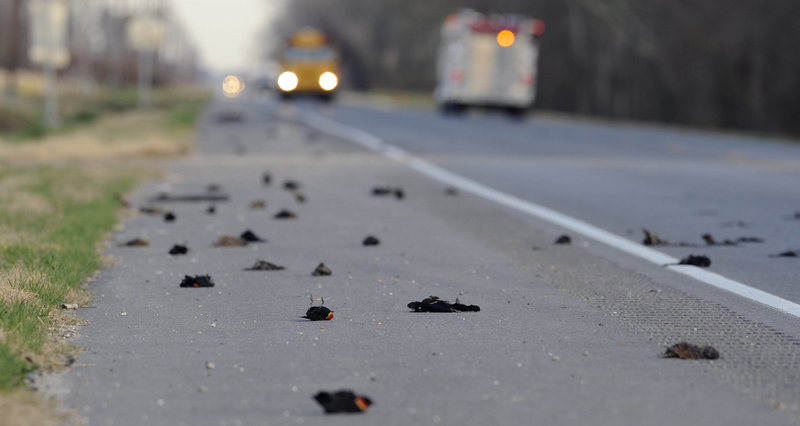WASHINGTON — First, the blackbirds fell out of the sky on New Year’s Eve in Arkansas. In recent days, wildlife have mysteriously died in big numbers: 2 million fish in the Chesapeake Bay, 150 tons of red tilapia in Vietnam, 40,000 crabs in Britain and other places across the world.
Blogs connected the deadly dots, joking about the “aflockalypse” while others saw real signs of something sinister, either biblical or environmental.
The reality, say biologists, is that these mass die-offs happen all the time and usually are unrelated.
Federal records show they happen on average every other day somewhere in North America. Usually, we don’t notice them and don’t try to link them to each other.
“They generally fly under the radar,” said ornithologist John Wiens, chief scientist at the California research institution PRBO Conservation Science.
Since the 1970s, the U.S. Geological Survey’s National Wildlife Health Center in Wisconsin has tracked mass deaths among birds, fish and other critters, said wildlife disease specialist LeAnn White. Sometimes it’s disease, sometimes pollution. Other times it’s just a mystery.
In the past eight months, the USGS has logged 95 mass wildlife die-offs in North America and that’s probably a dramatic undercount, White said. The list includes some 900 turkey vultures that seemed to drown and starve in the Florida Keys, 4,300 ducks killed by parasites in Minnesota, 1,500 salamanders done in by a virus in Idaho and 2,000 bats that died of rabies in Texas.
On average, 163 such events are reported to the federal government each year, according to USGS records. And there have been much larger die-offs than the 3,000 blackbirds in Arkansas. Twice in the summer of 1996, more than 100,000 ducks died of botulism in Canada.
Weather – cold and wet weather like in Arkansas New Year’s Eve when the birds fell out of the sky – is often associated with mass bird deaths, ornithologists say. Pollution, parasites and disease also cause mass deaths. Some are even blaming fireworks for the blackbird deaths.
So what’s happening this time?
Blame technology, says famed Harvard biologist E.O. Wilson. With the Internet, cell phones and worldwide communications, people are noticing events, connecting the dots more.
“This instant and global communication, it’s just a human instinct to read mystery and portents of dangers and wondrous things in events that are unusual,” Wilson told The Associated Press on Thursday.
Wilson and the others say instant communications – especially when people can whip out smart phones to take pictures of critter carcasses and then post them on the Internet – is giving a skewed view of what is happening in the environment.
The irony is that mass die-offs – usually of animals with large populations – are getting the attention while a larger but slower mass extinction of thousands of species because of human activity is ignored, Wilson said.
Copy the Story LinkSend questions/comments to the editors.



Success. Please wait for the page to reload. If the page does not reload within 5 seconds, please refresh the page.
Enter your email and password to access comments.
Hi, to comment on stories you must . This profile is in addition to your subscription and website login.
Already have a commenting profile? .
Invalid username/password.
Please check your email to confirm and complete your registration.
Only subscribers are eligible to post comments. Please subscribe or login first for digital access. Here’s why.
Use the form below to reset your password. When you've submitted your account email, we will send an email with a reset code.